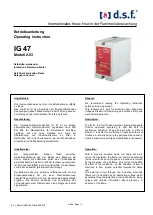
WIL-19013-E-02
13
SECTION 5
Wilden Equalizer Metal Surge Dampeners minimize pulsation and
protects in-line equipment.
Installation
Before installing an ISD dampener into operation, review cautions and
warnings as well as ensure that the materials of construction are
suitable for the application. Refer to Wilden’s Chemical Resistance
Guide for more information.
If installing an ISD dampener in a Wilden pump that is already in
operation, be sure to remove the pump from service and thoroughly
clean it prior to installation.
Install the ISD as shown below. A shut off valve on the inlet of ISD will
enable maintenance personnel to safely service the equipment. To
maximize effectiveness install the ISD as close as possible to the
discharge of the pump. It is important to support the pipe immediately
downstream from the ISD. Use a tee connector on the pump air
supply line and connect the line to the ISD 1/8” NPT inlet signaled by
an arrow. The ISD consumes very little air, therefore, a 1/4” hose is
more than adequate to supply enough air volume. When the air
supply to the pump is shut down, the air to the ISD will be shut off as
well.
Operation
Before putting the pulsating dampener into operation, the housing
bolts should be tightened as elements of construction tend to “settle”.
Troubleshooting
When there is a significant drop in fluid discharge pressure, there will
be a noticeable release of air through the small bleed hole in the air
regulator body. This is how the ISD metal dampener automatically
adjusts itself for optimal suppression. This is a good way of verifying
proper operation of the unit. If there is a continuous discharge of air
out this hole during steady fluid discharge pressure, the ISD is not
functioning properly and should be inspected. The ISD air regulator
body houses three O-rings which may need to be replaced.
For correct operation, the dampener will require its own air-supply
line, taken from the air supply-of the pump. The pump and dampener
are required to be connected to the same air pressure. Note that stop
or regulating valves may be placed between the pump and dampener.
The driving air has to be oil-free, dry and clean. The dampener
requires a minimum counter pressure of at least 1 bar (14.5 psig) for
optimal function. At startup, run the pump and dampener slowly prior
to full operation. Once adjusted and full of fluid, the dampener self-
regulates for all changing operating conditions.
It is recommended to tighten housing bolts after a few hours of
operation as well. Fixing bolts is necessary as well after long periods
of stoppage, extreme temperature variations, or transport/dismantling.
CAUTION:
Do not exceed 8.6 bar (125 psig) air
supply pressure.
NOTE:
In the event of a power failure, the shut-off valve should
be closed, if the restarting of the pump is not desirable once
power is regained.
Maintenance
When pump disassembly is required, before starting to disassemble
the pump, disconnect both the pump and the dampener from service.
Thoroughly empty and clean both the pump and dampener before
disassembly. Once maintenance is complete, refer to installation
guidance prior to putting the pump and dampener back into service.
SUGGESTED INSTALLATION, OPERATION, MAINTENANCE
AND TROUBLESHOOTING
This illustration is a generic representation of an air-operated double-diaphragm pump with an ISD metal dampener.
Summary of Contents for WILDEN PSG Equalizer ISD1520
Page 21: ...WIL 19013 E 02 21 NOTES ...
Page 22: ...WIL 19013 E 02 22 NOTES ...
Page 23: ...WIL 19013 E 02 23 NOTES ...










































